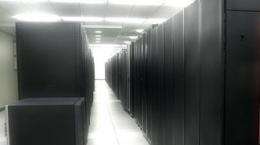A way to reduce the Internet's energy drain

(Phys.org) -- Swiss researchers at EPFL have developed a device intended for monitoring and saving the energy consumed by large data centers. It was developed in collaboration with Credit Suisse, which has used it to equip the power of its server racks.
A single click of the mouse triggers a surge of snapping devices and the activation of a multitude of connections. Finally, from one click to the other, the amount of electricity consumed becomes more and more significant. In fact, Internet currently represents 8% of the energy annually used in Switzerland, a figure that could soon reach the values of 15% to 20% in the coming years.
In order to respond to this situation, researchers at the Embedded Systems Laboratory (ESL) at EPFL have devised a solution that achieves significant energy savings, "of at least 30%, and even up to 50% less of what is consumed today, "said David Atienza, ESL director.
This new tool, called "Power Monitor System and Management (PMSM)", provides the means to monitor and track the power consumption of a data center. It can also be used to distribute the workload among several servers, computers that host the services offered on the Internet such as emailing, file sharing, business operations, data storage etc.
The system consists of an electronic box comprising a set of sensors. Each one of them can be connected either to the racks’ main power or directly to one of the cables supplying energy to the electronic components of the server. By measuring the current passing through it at some point, the sensor can gauge the power used, log the energy consumption variations and control that the system does not overheat. The information recorded is transmitted to a central server where the PMSM software is running. It is then processed together with other data - such as the room temperature or the priorities of the ongoing operations- and the system creates a table showing the evolution of the servers’ energy consumption, which can be accessed remotely and in real time.
More power in less space
The advantage of this invention is that it provides a precise and unique overview of the use of a server farm. In addition, this system is able to carry workloads from one machine to another, thus allowing significant energy savings. "Two servers running at 40% of their capacity each, consume much more than only one at 80%" explained David Atienza.
Developed at the request of Credit Suisse, which is seeking to reduce the energetic and economic cost of its data centers, this new tool has already been installed on the racks of approximately 5200 servers of the bank’s data center in Zurich. According to Marcel Ledergerber, responsible for the management of this complex, the solution proposed by the ESL laboratory is particularly attractive to them since it contributes to a process of "server virtualization" that the bank has been undergoing for some years already. Such a process aims at progressively reducing the number of servers hosting a gradually greater computing power."The PMSM system allows us to concentrate our machines in a smaller space", he said. "The specific information that it provides allows us to better control the issues of temperature, and thus manage our installations more safely."
Provided by Ecole Polytechnique Federale de Lausanne

















